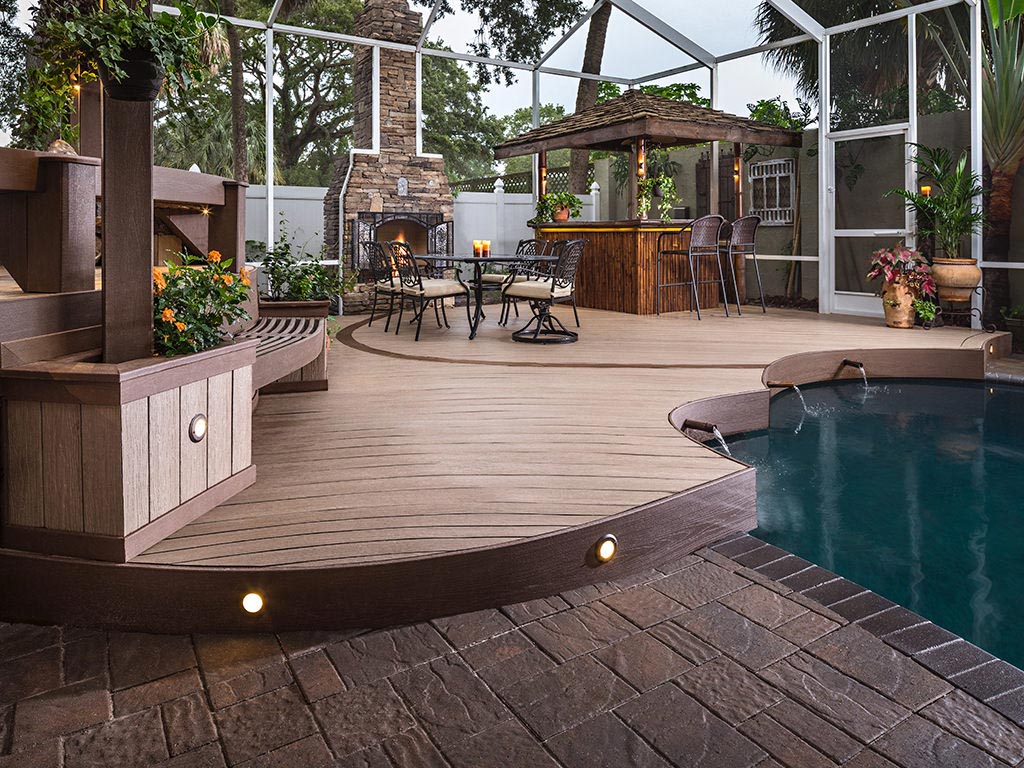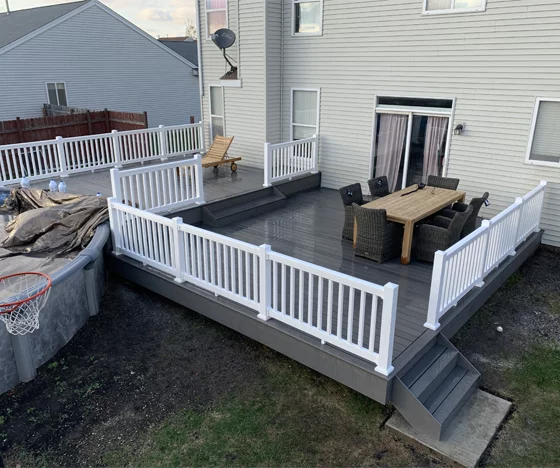Looking for expert deck installation near me to enhance your home’s exterior? Check your area.
Looking for expert deck installation near me to enhance your home’s exterior? Check your area.
Blog Article
How to Select the Right Materials for Your Deck Installation Task
Choosing the proper products for your deck installation project can appear challenging. The trick is to stabilize your budget, layout preferences, and way of living needs to develop a deck that will enhance your exterior area for years to come.
Understanding the Different Kinds Of Deck Products
When getting started on a deck setup project, the option of materials ends up being a pivotal decision. Various alternatives are available, each with one-of-a-kind characteristics and visual allure. Traditional timber, for example, offers an ageless, natural look and is generally much more cost-effective. However, it can warp in time and requires regular maintenance. Composite products, on the other hand, are a blend of wood and plastic, providing longevity and resistance to weather components. They require much less upkeep contrasted to wood however are typically a lot more expensive. One more option is plastic, which is practically maintenance-free and resistant to insects and rot, albeit less natural-looking. By understanding these differences, homeowners can make a more informed decision on the most ideal deck product for their certain needs.
Assessing the Resilience and Upkeep Needs of Deck Products
Examining the durability and upkeep demands of deck materials is an essential step in deck installation. Sturdiness includes the material's capacity to stand up to rough climate condition, wear and tear, and its longevity. For circumstances, cedar and redwood are naturally immune to rot and bugs, making them durable choices. On the various other hand, pressure-treated wood, while durable, might require even more upkeep as a result of its susceptibility to cracking and deforming.
Recognizing maintenance requirements is similarly essential. Some materials need routine securing or discoloring to preserve their appearance and resist dampness damages, while others, like composite decking, require much less maintenance. By examining these elements, one can pick one of the most suitable outdoor decking material, making certain a balance in between toughness, maintenance demands, and aesthetic allure.
Cost Evaluation: Contrasting Wood and Compound Decking
Although price might at first feel like a second concern, it is a substantial element when contrasting wood and composite outdoor decking. Wood, normally a much less expensive choice, has a lower ahead of time cost. Over time, maintenance costs can accumulate, potentially making wood extra costly in the long run. These maintenance prices may include staining, sealing, or changing harmed boards. On the other hand, composite outdoor decking, while costlier initially, needs less maintenance, possibly reducing long-term costs. Yet, it's crucial to keep in mind that composite decking isn't invulnerable to deterioration, and substitute prices can be high. As a result, possible deck proprietors should consider their budget plan and desire to preserve their decks when determining in between timber and composite outdoor decking.
Visual Appeals and Layout Adaptability of Decking Materials
All-natural timber outdoor decking gives a classic, timeless appearance, while composite products offer a broad variety of colors and structures to fit diverse preferences and designs. Compound products, while much less adaptable in layout, are still adaptable enough for many deck styles. These elements, as a result, are crucial components in the choice of outdoor decking product.
Environmental Effect of Decking Materials
When selecting decking materials, one should think about not only appearances and resilience, but also the environmental influence. It's important to assess the sustainability of materials and explore check my site recycled outdoor decking alternatives. In addition, recognizing the possible influence on neighborhood ecological communities will ensure a more environmentally accountable choice.
Evaluating Product Sustainability
In the realm of deck construction, examining product sustainability is a critical step. Composite outdoor decking materials frequently combine timber and plastic, decreasing the need for new timber yet boosting reliance on fossil fuels - deck installation near me. Thus, the selection of decking materials ought to balance performance, aesthetics, cost, and sustainability to guarantee an accountable and resilient setup.
Recycled Decking Choices

Compound outdoor decking is specifically popular because of its longevity and ease of maintenance. It's immune to rot, insects, and fading, making it a resilient choice. Recycled plastic outdoor decking, on the various other hand, is highly durable and needs very little maintenance. While these products might lug a greater initial cost, their longevity and decreased environmental effect make them a smart financial investment for the eco-conscious home owner.

Effect on Local Ecosystems
While the benefits of utilizing recycled materials for outdoor decking can not be overemphasized, it's similarly important to consider the broader ecological ramifications of these options. Proper disposal of old outdoor decking is essential to decreasing garbage dump waste. Essentially, an eco-conscious deck task needs careful product choice, sustainable sourcing, and responsible disposal.
Making Your Final Choice: Tips for Selecting the very best Deck Products
As the short article changes right into the subtopic of "Making Your Decision: Tips for Choosing the most effective Deck Products", it is vital to understand the selection of deck products available. advice Striking an equilibrium my explanation between durability and aesthetics is crucial in this choice procedure. The adhering to conversation will direct visitors in making an educated selection based on these crucial considerations.
Understanding Different Deck Materials
The job of picking the appropriate materials for your deck setup can seem intimidating because of the huge selection of alternatives offered. Recognizing the various materials can simplify this process. Wood is a preferred choice, offering a timeless visual and affordability. Kinds of wood utilized include pressure-treated lumber, cedar, and redwood. Composite materials, made from a mix of timber and plastic, are low-maintenance and immune to rot and bugs. Plastic or PVC decks are much more sturdy and require less upkeep than composite materials, however they can look much less all-natural. Aluminum decks are strong, light-weight, and immune to rot, yet they are also the most expensive choice. Each product has its own advantages and downsides, making it vital to consider your details demands prior to making a decision.
Durability vs. Appearances Equilibrium
Balancing toughness with aesthetics can be a challenge when selecting deck products. The decision typically comes down to individual preferences and the deck's meant use. High-traffic areas may demand long lasting materials like composite outdoor decking, which endures wear and tear yet may do not have the all-natural charm of timber. On the other hand, wood supplies an ageless appeal and heat that synthetic products struggle to replicate. It calls for much more upkeep and might not last as long. As a result, homeowners require to strike a balance, thinking about both the deck's practical needs and their aesthetic choices. By doing so, they can guarantee their deck remains a useful and attractive outside space for several years to come.
Verdict
In verdict, selecting the appropriate materials for your deck setup task needs careful consideration of variables such as longevity, maintenance, expense, visual appeals, and ecological impact. Whether you decide for conventional wood or composite materials, your selection ought to line up with your budget, design preferences, and lifestyle. Eventually, the most effective outdoor decking product is one that improves your outdoor space and offers satisfaction for several years to come.
Report this page